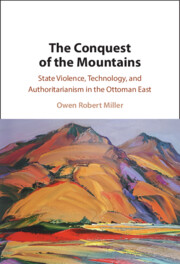
-
Select format
-
- Publisher:
- Cambridge University Press
- Publication date:
- November 2025
- December 2025
- ISBN:
- 9781009524940
- 9781009524957
- Dimensions:
- (229 x 152 mm)
- Weight & Pages:
- 256 Pages
- Dimensions:
- Weight & Pages:
You may already have access via personal or institutional login
Book description
In the late summer of 1894, Sultan Abdülhamid II ordered several battalions of Ottoman soldiers to destroy Armenian 'bandits' operating in the remote mountains of Sasun. Over a three-week period, these soldiers systematically murdered men, women, and children, beginning a chain of events which led directly to the Hamidian massacres of 1895 to 1897 and prefigured many of the patterns of the Medz Yeghern (Great Crime) of 1915–1917. Taking a microhistorical approach, Owen Robert Miller examines how the Ottoman State harnessed three nascent technologies (modern firearms, steamboats, and telegraphs) to centralize authority and envisage new methods of conquest. Alongside developing an understanding of how the violence took place, this study explores how competing narratives of the massacre unfolded and were both disseminated and repressed. Emphasizing the pivotal significance of geography and new technologies, The Conquest of the Mountains reveals how the tragic history of these massacres underscores the development of Ottoman State authoritarianism.
Reviews
‘A beautifully written, richly sourced exploration of the incessant exercise of state violence directed at the people in the mountains of the East. Deeply researched and a pathbreaking analysis on the Ottoman conquest of the mountains. Impressively expands the source base that scholars have thus far utilized in telling the history of massacres in the Sasun region in 1893–1894.'
Ümit Kurt - The University of Newcastle, Australia
Owen Robert Miller's riveting work dismantles the foundations of Ottoman historiography and reveals a hidden history of the Armenian genocide before 1915, exposing the brutal reality and unravelling a complicated story of Ottoman state violence cleverly masked as communal conflict. A gripping exploration that challenges perceptions and brings the hidden truth to light.
Kamal Soleimani - El Colegio de México
Contents
Metrics
Full text views
Full text views help Loading metrics...
Loading metrics...
* Views captured on Cambridge Core between #date#. This data will be updated every 24 hours.
Usage data cannot currently be displayed.
Accessibility standard: WCAG 2.2 AAA
Why this information is here
This section outlines the accessibility features of this content - including support for screen readers, full keyboard navigation and high-contrast display options. This may not be relevant for you.
Accessibility Information
The PDF of this book complies with version 2.2 of the Web Content Accessibility Guidelines (WCAG), offering more comprehensive accessibility measures for a broad range of users and attains the highest (AAA) level of WCAG compliance, optimising the user experience by meeting the most extensive accessibility guidelines.
Content Navigation
Table of contents navigation
Allows you to navigate directly to chapters, sections, or non‐text items through a linked table of contents, reducing the need for extensive scrolling.
Index navigation
Provides an interactive index, letting you go straight to where a term or subject appears in the text without manual searching.
Reading Order and Textual Equivalents
Single logical reading order
You will encounter all content (including footnotes, captions, etc.) in a clear, sequential flow, making it easier to follow with assistive tools like screen readers.
Short alternative textual descriptions
You get concise descriptions (for images, charts, or media clips), ensuring you do not miss crucial information when visual or audio elements are not accessible.
Full alternative textual descriptions
You get more than just short alt text: you have comprehensive text equivalents, transcripts, captions, or audio descriptions for substantial non‐text content, which is especially helpful for complex visuals or multimedia.
Visualised data also available as non‐graphical data
You can access graphs or charts in a text or tabular format, so you are not excluded if you cannot process visual displays.
Visual Accessibility
Use of colour is not sole means of conveying information
You will still understand key ideas or prompts without relying solely on colour, which is especially helpful if you have colour vision deficiencies.
Use of high contrast between text and background colour
You benefit from high‐contrast text, which improves legibility if you have low vision or if you are reading in less‐than‐ideal lighting conditions.

